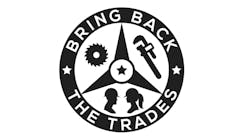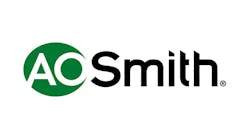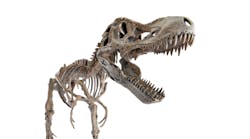Latest from Training
Sponsored
We need to learn to stream dinosaur dust in our new self-learning online environments. This industry has a practice of dumping large pieces of information -- which I call "the dinosaur dump" – and that method of teaching is just not working for the next generation, that generation of kids who will one day be in the vanguard of our industry, the same way we are now.
We need to break those large, important chunks of our knowledge into mini moments that are of use to the new workforce. In fact, we need to crush them into dust – Dinosaur Dust if you want to give it a name – that we can then deliver to that generation in a steady stream.
So this is an open call to experts around the industry: can you help me figure out how best to do this? Can you help me connect our reality to their virtuality.
An image of us old folks handing some member of that new generation a VHS tape, a CD, or even (heaven help us!) a book, a printed chart, or graph that had been useful to us at some point in our prior experience pops into my head. They look at us with a puzzled expression, then return to multi-tasking their job while streaming music from their phone. Nothing is communicated.
What is the URL of this? How can I search this to find it when I need it? and Why are you telling me this now? I will learn this only when I need to know it. Only give me this information when I need it.
They live in a world where their contextualized data is streamed on their demand. We have information we believe will be of use to them, but it is formatted and contextualized as a dinosaur dump that they can see only as a burden.
We need to enter their world of Slack, self-learning Wikipedia, web searches, machine learning, and other productivity tools. We need to sprinkle our Dinosaur Dust while contextualizing it into our mutually created self-learning environments.
It is likely as we go on this journey of re-packaging, re-contextualizing, that some of our extremely valuable information may no longer be relevant in their changing virtual world. But keep in mind, that new, virtual, Big Data world is not just their world, it is our world now as well. We need to work as a team to make our gems of information relevant, digestible and most of all useful.
Thinking like the new generation and learning how to stream relevent information into an online, self-learning, agile corporate data stream may be our greatest education yet.
We have important information to share with the new workforce, but we all need to learn how best to share it.
AutomatedBuildings.com has 19 years of industry articles, interviews, columns, and news a great collection of dinosaur dust, all dated and with its own URL. As you search and find useful information anywhere (not just on our website) you add another piece to the puzzle. Post links and share your own finds in our self-learning media network. If we as an industry start sharing the "ah ha" moments with our self-teaching environments we can get that Dinosaur Dust streaming.
This is another great resource for teaching videos; http://controltrends.org/category/training-2/
We need to change our present approach of information dumping.
As I watched and listened a session at the Realcomm event in San Diego called “The Changing Workforce: Integrating MILLENNIALS in the Workplace,” the comment was made that if we wanted to attract the younger workforce, we needed to get into their space and understand how they learn and what is important to them.
Talent attraction and retention has always been important; today that work includes a lot of conversations about Millennials.
Current information illustrates the generational difference between Baby Boomers, Gen-X, and Millennials. This young generation uses technology differently; they have different work styles and ways of communicating. Some organizations have resolved ways to integrate the traits of the different generations, while others still struggle. In just a few short years, Millennials will be the majority in the workforce, and it is imperative that we transition the skills and experience to them in the most efficient and effective way. This valuable session included speakers from various generations and the discussion focused on the successes and challenges involved in the multi-generational workplace.
In this article, Cope with the IOT Revolution by Staying Agile, the moderator of this event, Brad White, talks about the change in how we work.
As the smart building industry rapidly evolves, management strategies pioneered by software developers can help us successfully adapt. From Brad White, (P.Eng, MASc, Principal) and Christopher Naismith, (BASc, EIT, LEED GA Energy Efficiency Engineer, SES Consulting Inc.) comes these words:
Recently having completed our first development sprint, initial feedback from this process has been very positive. Stakeholders feel that their specific needs are being heard, the development team is excited to be working collaboratively on challenging problems, and leaders have higher confidence in the valuable throughput. ... Crucially, from a business perspective, we’re not allocating any more resources or funds than we were previously using on improving tools and processes. But with clear priorities, dedicated team members, and a well-defined approach we intend this to be a much more effective use of these resources.
In the IOT era, we are all developers now to some extent or another; it’s time to start acting like it.
(For more reading on the educational challenges – and opportunities – facing our industry, check out: http://www.contractormag.com/iot/bridging-skill-gap-autodidactic-open-education)
And for even more of my thoughts on Dinosaur Dust, check out this Smart Buildings VideoCast|PodCast interview with Yours Truly and best-selling author, Mark Jewell.
Ken Sinclair | Editor/Owner/Founder
Ken Sinclair has been called an oracle of the digital age. He sees himself more as a storyteller and hopes the stories he tells will be a catalyst for the IoT future we are all (eventually) going to live. The more than 50 chapters in that ongoing story of digital transformation below are peppered with HTML links to articles containing an amazing and diverse amount of information.
Ken believes that systems will be smarter, self-learning, edgy, innovative, and sophisticated, and to create, manage and re-invent those systems the industry needs to grow our most important resource, our younger people, by reaching out to them with messages about how vibrant, vital and rewarding working in this industry can be.


